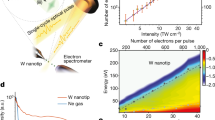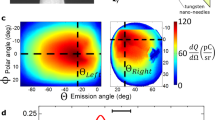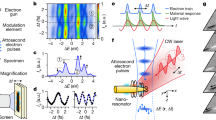Abstract
Collective electron motion in condensed matter typically unfolds on a sub-femtosecond timescale. The well-defined electric field evolution of intense, phase-stable few-cycle laser pulses provides an ideal tool for controlling this motion. The resulting manipulation of local electric fields at nanometre spatial and attosecond temporal scales offers unique spatio-temporal control of ultrafast nonlinear processes at the nanoscale, with important implications for the advancement of nanoelectronics. Here we demonstrate the attosecond control of the collective electron motion and directional emission from isolated dielectric (SiO2) nanoparticles with phase-stabilized few-cycle laser fields. A novel acceleration mechanism leading to the ejection of highly energetic electrons is identified by the comparison of the results to quasi-classical model calculations. The observed lightwave control in nanosized dielectrics has important implications for other material groups, including semiconductors and metals.
This is a preview of subscription content, access via your institution
Access options
Subscribe to this journal
Receive 12 print issues and online access
$209.00 per year
only $17.42 per issue
Buy this article
- Purchase on Springer Link
- Instant access to full article PDF
Prices may be subject to local taxes which are calculated during checkout




Similar content being viewed by others
References
Vasa, P., Ropers, C., Pomraenke, R. & Lienau, C. Ultra-fast nano-optics. Laser Photon. Rev. 3, 483–507 (2009).
Stockman, M. I. Ultrafast nanoplasmonics under coherent control. New J. Phys. 10, 025031 (2008).
Kim, S. et al. High-harmonic generation by resonant plasmon field enhancement. Nature 453, 757–760 (2008).
Sukharev, M. & Seideman, T. Coherent control approaches to light guidance in the nanoscale. J. Chem. Phys. 124, 144707–144708 (2006).
Furube, A., Du, L., Hara, K., Katoh, R. & Tachiya, M. Ultrafast plasmon-induced electron transfer from gold nanodots into TiO2 nanoparticles. J. Am. Chem. Soc. 129, 14852–14853 (2007).
Cavalieri, A. L. et al. Intense 1.5-cycle near infrared laser waveforms and their use for the generation of ultra-broadband soft-x-ray harmonic continua. New J. Phys. 9, 242 (2007).
Goulielmakis, E. et al. Single-cycle nonlinear optics. Science 320, 1614–1617 (2008).
Krausz, F. & Ivanov, M. Attosecond physics. Rev. Mod. Phys. 81, 163–234 (2009).
Uiberacker, M. et al. Attosecond real-time observation of electron tunnelling in atoms. Nature 446, 627–632 (2007).
Goulielmakis, E. et al. Real-time observation of valence electron motion. Nature 466, 739–743 (2010).
Cavalieri, A. L. et al. Attosecond spectroscopy in condensed matter. Nature 449, 1029–1032 (2007).
Stockman, M. I., Kling, M. F., Kleineberg, U. & Krausz, F. Attosecond nanoplasmonic-field microscope. Nature Photon. 1, 539–544 (2007).
Baltuska, A. et al. Attosecond control of electronic processes by intense light fields. Nature 421, 611–615 (2003).
Paulus, G. G. et al. Measurement of the phase of few-cycle laser pulses. Phys. Rev. Lett. 91, 253004 (2003).
Kling, M. F. et al. Control of electron localization in molecular dissociation. Science 312, 246–248 (2006).
Dombi, P. et al. Observation of few-cycle, strong-field phenomena in surface plasmon fields. Opt. Express 18, 24206–24212 (2010).
Stockman, M. I. & Hewageegana, P. Absolute phase effect in ultrafast optical responses of metal nanostructures. Appl. Phys. A 89, 247–250 (2007).
Dombi, P., Rácz, P. & Bódi, B. Surface plasmon enhanced electron acceleration with few-cycle laser pulses. Laser Part. Beams 27, 291–296 (2009).
Irvine, S. E., Dombi, P., Farkas, G. & Elezzabi, A. Y. Influence of the carrier-envelope phase of few-cycle pulses on ponderomotive surface-plasmon electron acceleration. Phys. Rev. Lett. 97, 146801 (2006).
Donnelly, T. D., Ditmire, T., Neuman, K., Perry, M. D. & Falcone, R. W. High-order harmonic generation in atom clusters. Phys. Rev. Lett. 76, 2472–2475 (1996).
Bhardwaj, V. R., Corkum, P. B. & Rayner, D. M. Recollision during the high laser intensity ionization of C60 . Phys. Rev. Lett. 93, 043001 (2004).
Fennel, T. et al. Plasmon-enhanced electron acceleration in intense laser metal-cluster ineteractions. Phys. Rev. Lett. 98, 143401 (2007).
Shu, J. et al. Elastic light scattering from nanoparticles by monochromatic vacuum-ultraviolet radiation. J. Chem. Phys. 124, 034707–034709 (2006).
Bresch, H. et al. Elastic light scattering from free sub-micron particles in the soft X-ray regime. Faraday Discuss. 137, 389–402 (2008).
Skopalova, E. et al. Pulse-length dependence of the anisotropy of laser-driven cluster explosions: Transition to the impulsive regime for pulses approaching the few-cycle limit. Phys. Rev. Lett. 104, 203401 (2010).
Mathur, D. & Rajgara, F. A. Communication: Ionization and Coulomb explosion of xenon clusters by intense, few-cycle laser pulses. J. Chem. Phys. 133, 061101–061104.
Springate, E., Aseyev, S. A., Zamith, S. & Vrakking, M. J. J. Electron kinetic energy measurements from laser irradiation of clusters. Phys. Rev. A 68, 053201 (2003).
Kumarappan, V., Krishnamurthy, M. & Mathur, D. Asymmetric emission of high-energy electrons in the two-dimensional hydrodynamic expansion of large xenon clusters irradiated by intense laser fields. Phys. Rev. A 67, 043204 (2003).
Fennel, T. et al. Laser-driven nonlinear cluster dynamics. Rev. Mod. Phys. 82, 1793–1842 (2010).
Znakovskaya, I. et al. Attosecond control of electron dynamics in carbon monoxide. Phys. Rev. Lett. 103, 103002 (2009).
Yang, B. et al. Intensity-dependent scattering rings in high order above-threshold ionization. Phys. Rev. Lett. 71, 3770–3773 (1993).
Paulus, G. G., Nicklich, W., Xu, H., Lambropoulos, P. & Walther, H. Plateau in above threshold ionization spectra. Phys. Rev. Lett. 72, 2851–2854 (1994).
Paulus, G. G. et al. Absolute-phase phenomena in photoionization with few-cycle laser pulses. Nature 414, 182–184 (2001).
Busuladžić, M., Gazibegović-Busuladžić, A. & Milošević, D. High-order above-threshold ionization in a laser field: Influence of the ionization potential on the high-energy cutoff. Laser Phys. 16, 289–293 (2006).
Kling, M. F. et al. Imaging of carrier-envelope phase effects in above-threshold ionization with intense few-cycle laser fields. New J. Phys. 10, 025024 (2008).
Jacoboni, C. & Reggiani, L. The Monte Carlo method for the solution of charge transport in semiconductors with applications to covalent materials. Rev. Mod. Phys. 55, 645–705 (1983).
Salieres, P. et al. Feynman’s path-integral approach for intense-laser-atom interactions. Science 292, 902–905 (2001).
Schenk, M., Krüger, M. & Hommelhoff, P. Strong-field above-threshold photoemission from sharp metal tips. Phys. Rev. Lett. 105, 257601 (2010).
Liseykina, T. V., Pirner, S. & Bauer, D. Relativistic Attosecond electron bunches from laser-illuminated droplets. Phys. Rev. Lett. 104, 095002 (2010).
Zaretsky, D. F., Korneev, Ph. & Becker, W. High-order harmonic generation in clusters irradiated by an infrared laser field of moderate intensity. J. Phys. B 43, 105402 (2010).
Otobe, T., Yabana, K. & Iwata, J. I. First-principles calculation of the electron dynamics in crystalline SiO2 . J. Phys. Condens. Matter. 21, 064224 (2009).
Durach, M., Rusina, A., Kling, M. F. & Stockman, M. I. Metallization of nanofilms in strong adiabatic electric fields. Phys. Rev. Lett. 105, 086803 (2010).
Acknowledgements
The authors acknowledge W. Siu and K. J. Schafer for making their TSDE data available to us, M. Kübel for helping with the laser intensity calibration, and S. Watson for providing experimental support. We are grateful for support by the Max-Planck Society, the EU through a Marie-Curie Reintegration Grant and the ATTOFEL network, and by the DFG through the Emmy-Noether program, the Cluster of Excellence: Munich Center for Advanced Photonics (MAP), SPP1391 and SFB 450 as well as BMBF through the network PhoNa and grant nos: 05KS7KEA and 05K10KE2. M.F.K. acknowledges support from KAIN within the KSU-MPQ collaboration. T.F. and C.P. gratefully acknowledge financial support from the DFG within SFB 652/2. I.A. is grateful for support from the Higher Education Commission of Pakistan (HEC-DAAD 2006/11586). The work of M.I.S. and M.F.K. has been supported by grants from the Chemical Sciences, Biosciences and Geosciences Division of the Office of the Basic Energy Sciences, Office of Science, US Department of Energy. M.I.S. acknowledges support by BaCaTeC and the US–Israel Binational Science Foundation.
Author information
Authors and Affiliations
Contributions
E.R. and M.F.K. conceived the experiment; S.Z., J.P., E.A., I.Z. and B.L. performed the measurements; C.G. synthesized and characterized the SiO2 nanoparticles; S.Z., J.P., I.Z., M.J.J.V., M.I.S., F.K., E.R. and M.F.K. evaluated, analysed and interpreted the experimental data; F.S. and C.P. did FDTD calculations, and T.F. developed the theoretical model and performed the Monte Carlo trajectory calculations. All authors discussed the results and contributed to the final manuscript.
Corresponding authors
Ethics declarations
Competing interests
The authors declare no competing financial interests.
Supplementary information
Supplementary Information
Supplementary Information (PDF 862 kb)
Rights and permissions
About this article
Cite this article
Zherebtsov, S., Fennel, T., Plenge, J. et al. Controlled near-field enhanced electron acceleration from dielectric nanospheres with intense few-cycle laser fields. Nature Phys 7, 656–662 (2011). https://doi.org/10.1038/nphys1983
Received:
Accepted:
Published:
Issue Date:
DOI: https://doi.org/10.1038/nphys1983
This article is cited by
-
Attosecond field emission
Nature (2023)
-
Anomalous formation of trihydrogen cations from water on nanoparticles
Nature Communications (2021)
-
Plasma channel formation in NIR laser-irradiated carrier gas from an aerosol nanoparticle injector
Scientific Reports (2019)
-
Sub-cycle dynamics in relativistic nanoplasma acceleration
Scientific Reports (2019)
-
Extreme nonlinear strong-field photoemission from carbon nanotubes
Nature Communications (2019)



